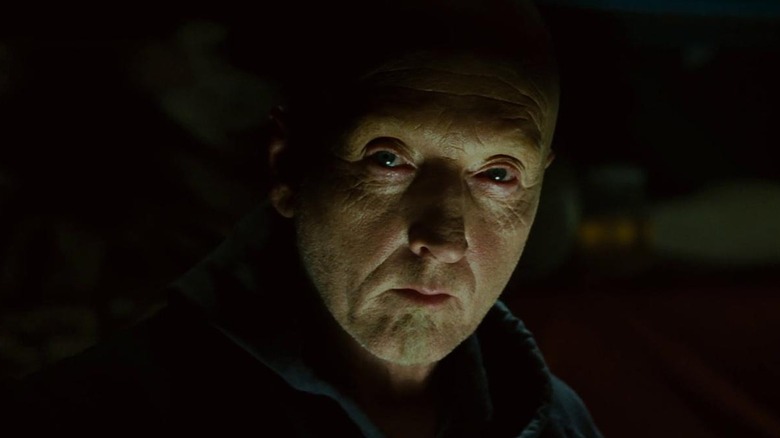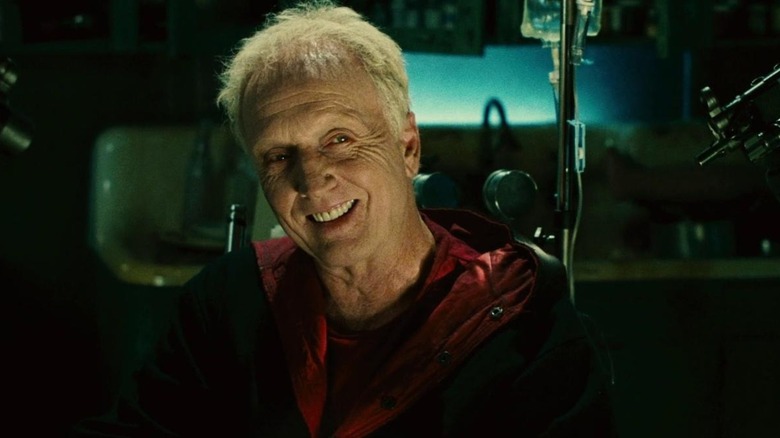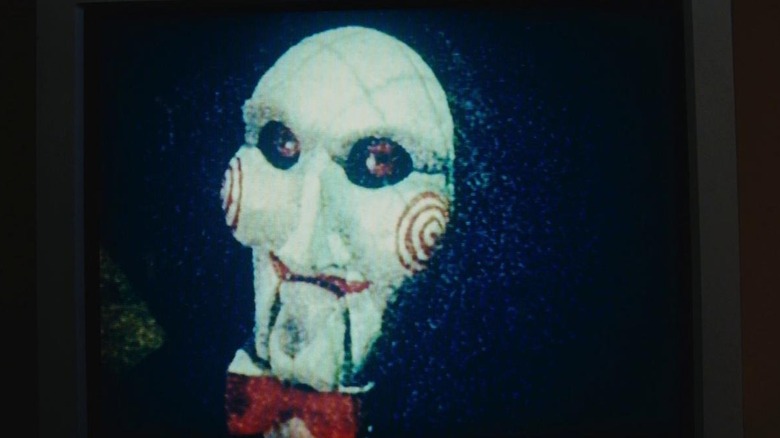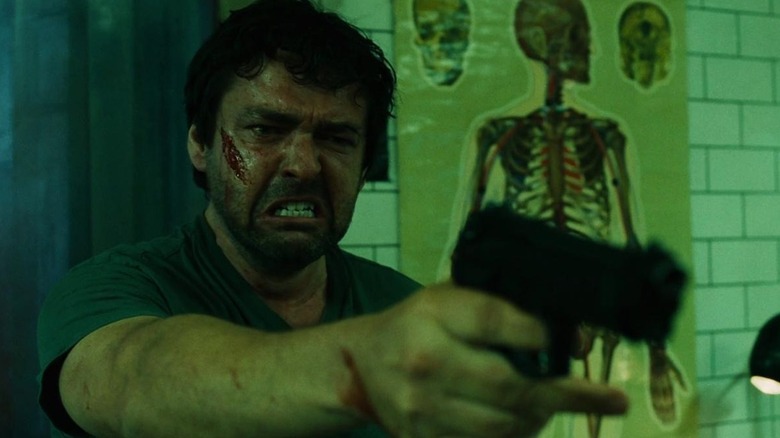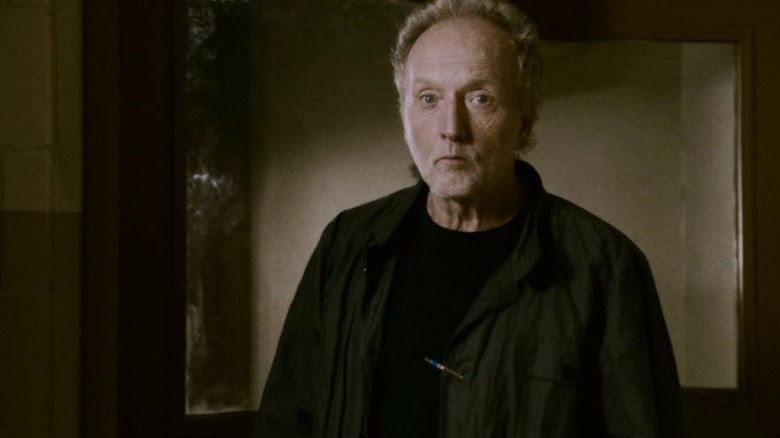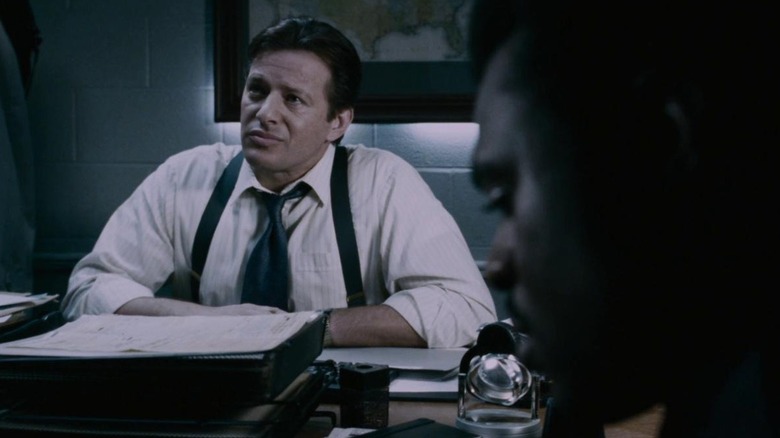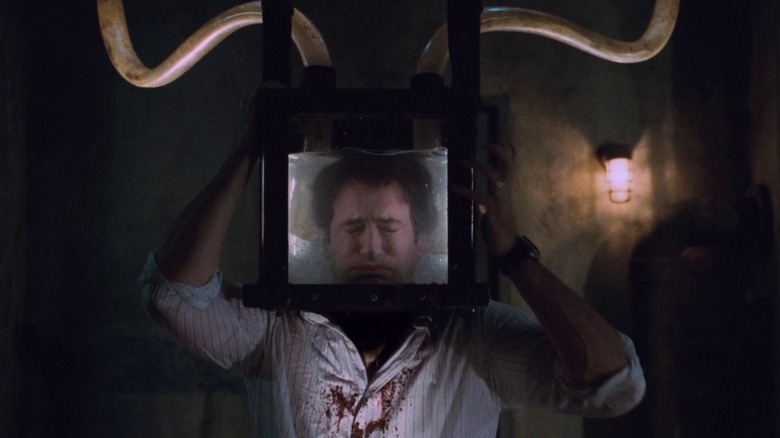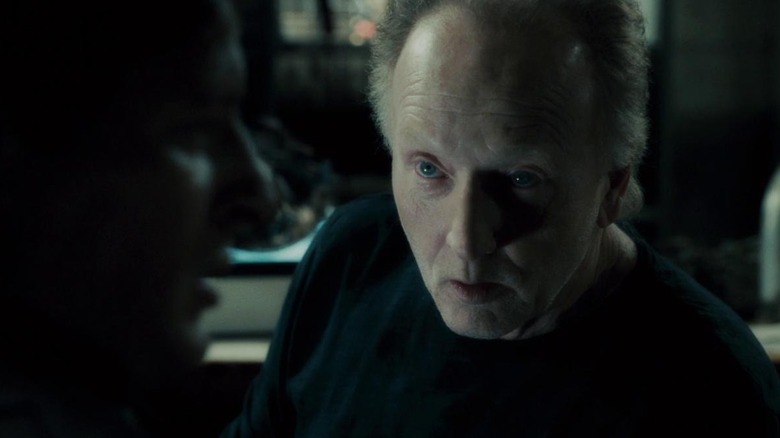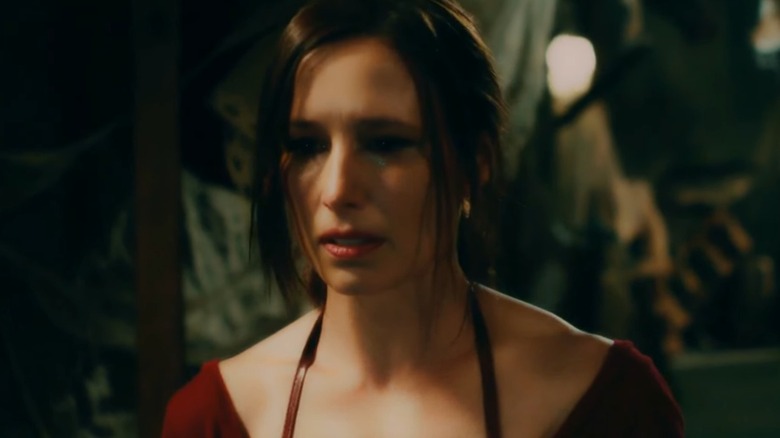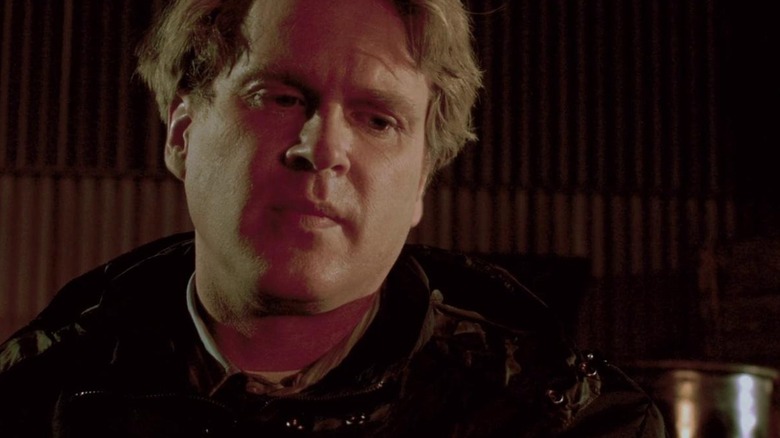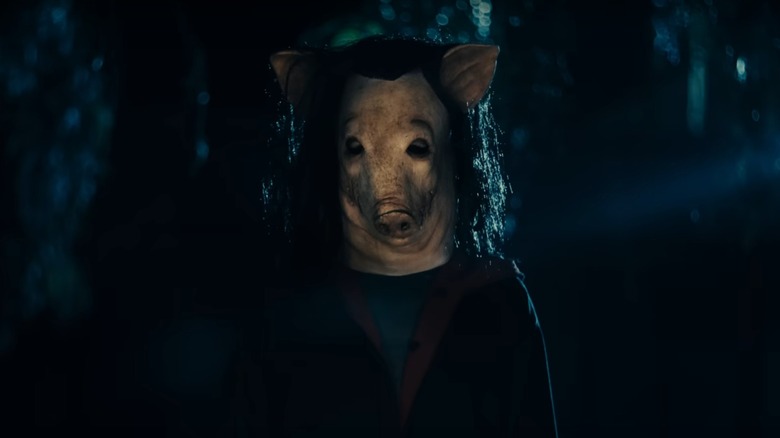Every Alternate Ending For The Saw Franchise Explained
Spoilers ahead for every "Saw" movie.
What has given the "Saw" franchise its incredible staying power? Is it the gore or the quick-cut editing? Maybe it's the villain and sometimes protagonist John Kramer, played by Tobin Bell. There's a handful of elements that have made the series popular. Nu metal has, concerningly, had a role to play, but the real stars of the "Saw" franchise are the twist endings.
Every "Saw" film has an ending that you wouldn't have believed when you first sat down to watch the story unfold. Sometimes the twists are carefully layered throughout the rest of the film. Sometimes they're wild left turns that rewrite the entire "Saw" franchise timeline in an attempt to get one over on the audience. Either way, the endings are always a raucous surprise that have to be seen to be believed.
The "Saw" franchise kicked off right at the peak of DVD culture. That means plenty of the movies came with unrated versions, director's cuts, and DVD extras. Sometimes that DVD package came with a slightly altered ending as a special treat. The full "Saw" story is hard enough to follow without all these variations, so here's a rundown on every alternate ending the "Saw" franchise has ever given us.
Saw II had four alternate endings
Released in 2004, the first "Saw" movie introduces John Kramer and lays the groundwork for the rest of the franchise. Its biggest influence on the rest of the series might be its ending. The original movie's surprise twist set a precedent that all "Saw" movies should have some kind of shocking conclusion. For a long time, the filmmakers were willing to go to extreme lengths to keep the ending of a new "Saw" movie a secret.
Costas Mandylor had an ongoing role in the franchise as Detective Mark Hoffman, a hero-turned-killer who's obsessed with Jigsaw's work. In 2010, Mandylor told ScreenRant, "They always shoot alternate endings, and I never know if I'm dead or not." The big twist at the end of each movie was so top secret that the writers and directors working on the film went out of their way to keep the actors in the dark just to prevent any leaks.
"Saw II" really kicked off the trend of filming multiple endings. After the surprise ending of "Saw" delighted audiences, "Saw II" had a high bar to pass. According to legend, at least four different endings were written and shot, but only one made it into the final cut of the film. Later movies released some alternate endings on unrated and director's cut DVDs, but "Saw II" kept its alternate endings a total secret.
What happened at the end of the theatrical cut of Saw III?
"Saw III" focuses on a handful of new Jigsaw victims, but Lynn (Bahar Soomekh) and Jeff (Angus Macfadyen) take center stage. Lynn is a surgeon, and Amanda (Shawnee Smith) kidnaps her and forces her to operate on John to keep him alive while the other victims play out their games. Jeff is a grief-stricken father whose son died in a drunk driving incident. Jeff has become consumed by revenge, so Jigsaw puts him through various tests to teach him the error of his ways.
The end of the movie reveals that Jeff and Lynn are actually married. When an argument between Amanda and John takes a left turn, Amanda shoots Lynn just as Jeff enters the operating room. Jeff kills Amanda, but then John gives Jeff a choice between forgiving John for what's happened or killing him then and there.
Jeff slices John's throat with a saw, but as he starts to bleed out, John pushes play on a tape recorder. In the recording, John explains that he's been one step ahead of Jeff this entire time. He kidnapped Jeff's daughter, and he would have returned her if Jeff had forgiven him. Instead, one last Jigsaw trap kills Lynn and locks Jeff in the operating room, leaving his daughter to die ... or so it seems.
Saw III's alternate ending zoomed in on Jeff's misery
There are two alternate versions of the ending of "Saw III," but neither of them makes any significant changes to the way everything plays out. The unrated cut of the film introduces the subtlest changes in the form of a few minor editing differences in the final scene. The camera focuses more on the wound in John's throat, and the montage of previous Jigsaw victims and traps is slightly longer. Ultimately, the unrated version doesn't change anything from the perspective of the characters in the scene.
The director's cut changes things a bit more, but it doesn't alter the actual events of the story. In this version, John drops his tape recorder when he dies. Jeff retrieves it after John's last trap violently blows Lynn's head off. A visibly shaken Jeff sits down next to his dead wife and promises her that he's going to get them out of the room. He picks up Lynn's bloody hand and kisses it, then he plays the tape and learns about Jigsaw's last twist. This ending gives more screen time to Lynn's gruesome and fatal injury, and it lingers on Jeff's utter sense of loss after witnessing his wife's death. Like the unrated cut's ending, though, the director's cut doesn't change Jeff's fate in any way. That said, there are enough differences to fuel debate among fans who are split down the middle on whether they prefer the theatrical or director's cut of the film.
What happened at the end of the theatrical cut of Saw IV?
In general, a big twist at the end of a movie is supposed to surprise you and recontextualize everything you've already seen. The best twists make you want to go back and watch everything all over again so you can spot the little clues that were laid out along the way. "Saw IV" actually has two twists in its story, but one of them only works because the movie lies to you.
Careful scene placement and editing lead you to believe that "Saw IV" is a true sequel to "Saw III." In reality, only the autopsy scene takes place after "Saw III." The most shocking part of the movie reveals that the events in both films happen more-or-less simultaneously. As the movie comes to a close, FBI Agent Peter Strahm (Scott Patterson) walks into the very operating room where Jeff killed John Kramer in "Saw III." Strahm thinks that Jeff is about to attack him and shoots, killing Jeff.
Meanwhile, Officer Daniel Rigg (Lyriq Bent) is uncovering the movie's other big surprise. Throughout the film, Rigg makes his way through a variety of traps that Jigsaw seemingly set up before he died. In his final trap, Rigg learns that his partner Hoffman has really been helping Jigsaw set things in motion this whole time. The movie ends with Hoffman locking Rigg and Strahm inside Jigsaw's factory, leaving them both for dead.
Saw IV's unrated cut makes the ending more confusing
When "Saw IV" made its way to DVD, we got an unrated cut that made some slight changes to a few scenes in the movie. Unfortunately for fans who love to have brand new content to sift through, the "Saw IV" DVD continued the trend of only releasing surface-level changes to the theatrical cut of the film. Though the unrated cut introduces some differences in the final scene of the movie, they don't amount to anything all that impactful. In a way, the changes in editing actually make the ending more difficult to follow.
When Rigg is heading into his final trap, he believes that Hoffman has become another of Jigsaw's victims. In the trap room, Hoffman is strapped to a chair, apparently preparing to be electrocuted. The unrated cut of the film really focuses on Rigg in this scene, and in doing so it cuts out a shot of Hoffman untying himself from the chair and getting up to leave Rigg trapped in the factory. Without that brief shot, the reveal that Hoffman has been in on Jigsaw's scheme from the beginning doesn't have a second to breathe. That's why some fans on Reddit have argued that in this instance, the theatrical version of "Saw IV" actually works much better than the special unrated edition.
Saw V originally killed off Strahm differently
"Saw V" follows Strahm as he tries to pin Hoffman as Jigsaw's secret accomplice. At the end of the movie, Hoffman and Strahm face off, but Hoffman escapes their fight as a mechanical room squeezes in its walls and crushes Strahm to death.
The ending is a sickening play on the trash compactor scene from 1977's "Star Wars," and as far as Jigsaw traps go, it's a pretty satisfying one. When the film was still in the planning stages, the filmmakers had a dramatically different ending in mind for Strahm. David Hackl, the director of "Saw V" and a longtime production designer on the franchise, revealed in a 2018 interview that Strahm's death was planned as a callback to the beginning of the film.
Early in the movie, Hoffman has his head stuck in a box that is filling up with water. He has to plunge a pen through his throat in order to keep breathing. Hackl said that the final trap was supposed to be a massive water box. Hoffman would get in the glass box and survive while Strahm drowned as the entire room filled with water. According to Hackl, the water room would have stretched the movie's budget too far and there were massive safety concerns about having the actors fully submerged. Because they wanted to keep the movie as full of practical effects as possible, they decided to change the trap.
What happened at the end of the theatrical cut of Saw VI?
"Saw VI" picks up where "Saw V" leaves off. Hoffman gets busy working on a new set of games, but he has to split his focus throughout the movie. He's trying to continue Jigsaw's legacy while also covering his tracks from the prying eyes of FBI agent Dan Erickson (Mark Rolston). Erickson has his suspicions about Strahm's involvement with Jigsaw. His investigation leads him to uncovering Hoffman's real role in the plot, but before he can tell anyone about what he's discovered, Hoffman kills him.
With Erickson dead, Hoffman might think that he's finally in the clear. Unfortunately for him, that's far from the truth. It turns out that Jigsaw had some concerns about Hoffman's ability to carry on his work. Before he died, John Kramer left his wife Jill (Betsy Russell) a box containing proof of Hoffman's involvement in the killings and a way to give Hoffman a Jigsaw test of his very own. Jill manages to get Hoffman locked up in a new version of Jigsaw's classic reverse bear trap game.
Hoffman doesn't die, though. Using the metal of the bear trap, he manages to crush the bones in his hand and free himself from his restraints. At the very last second, Hoffman positions the bear trap between two metal bars, so it can't fully open and rip his skull apart. His face is cut, and as he screams in pain, the movie cuts to black.
Saw VI's alternate ending brings back Amanda
Like the "Saw" movies that came before it, "Saw VI" got an unrated release on DVD that came with some minor changes. The new version leans more heavily on the film's gore, but it leaves the original ending intact. The unrated cut altered the way the movie cuts between Hoffman's bear trap and William's (Peter Outerbridge) death, but it didn't change how either event plays out in any way. Much like the other unrated "Saw" cuts, fans weren't particularly impressed, and many prefer the theatrical version of the film.
The new version of the movie added a post credits scene featuring Jigsaw's old apprentice Amanda that isn't in the theatrical cut. Bizarrely, the scene has nothing to do with the events of "Saw VI" at all. It takes place in between "Saw IV" and "Saw V." In the scene, Amanda shows up to speak to Jeff's daughter before Hoffman has the chance to come rescue her as part of maintaining his cover on the police force. Amanda is clearly very shaken, and she all but begs the little girl trapped in the cell not to trust the man who saves her. Then the movie cuts to a brief shot of Hoffman carrying the girl to safety. The scene is definitely an odd inclusion because it doesn't really have any impact on the story of "Saw V" or "Saw VI," but it does give fans a little more insight into Amanda.
Saw 3D once again used multiple alternate endings
Believe it or not, "Saw 3D" was supposed to be the last entry in the entire franchise. Of course, fans had their doubts about that, and it turns out the filmmakers might have as well. Much like "Saw II," they filmed several different endings for "Saw 3D." Some of them might have even left room for Hoffman to stick around for another movie.
That didn't pan out. Only one ending for "Saw 3D" was ever released. In it, Hoffman gets revenge on Jill by killing her with the reverse bear trap. After that, three attackers wearing robes and pig masks – including Dr. Gordon (Cary Elwes) from the very first "Saw" movie — nab him. Dr. Gordon locks Hoffman inside the bathroom where Jigsaw once tested him, but Hoffman isn't being tested; he's just being left to die.
Fans have mixed feelings about the events of "Saw 3D," largely because of the film's ending. The ending sets up a slew of new Jigsaw followers, but all these years later, some fans are still wondering who the other masked characters were supposed to be. Unsatisfied with the ending they got, some fans have edited together their own takes on how the dramatic conclusion to the "Saw" franchise should have panned out. Of course, the series didn't end with "Saw 3D," and its direct sequel "Jigsaw" gave the franchise another breath of fresh air.
Will we get an alternate ending for Saw X?
After nearly 20 years, the "Saw" franchise needed a new spark. "Saw X" didn't exactly provide that, but it did give fans a story that returned to the roots of the franchise. Set between the events of "Saw" and "Saw II," the movie follows John Kramer seeking an experimental treatment for his terminal cancer. The story provides some new insight into John's life and his motivations for becoming Jigsaw. Because of where it falls in the timeline, it couldn't make any drastic changes to the overall story, but that didn't prevent it from being one of the most successful "Saw" films to date.
"Saw X" managed to do what no other "Saw" film had done — it impressed critics while also making a killing at the box office. Surprisingly, it's one of the few movies that doesn't include some kind of dramatic twist at the end. There are a few unexpected moments to be sure, but nothing in "Saw X" will take you completely by surprise. That conspicuous absence is enough to make anyone wonder if we'll see an alternate ending sometime in the future.
Despite the success of the movie, the ending that we experienced in theaters is probably the one we're stuck with. As we've seen, the "Saw" movies aren't big on restructuring their endings with alternate cuts. Especially considering where "Saw X" lands in the timeline, it's safe to assume the ending of "Saw X" is a settled matter.
